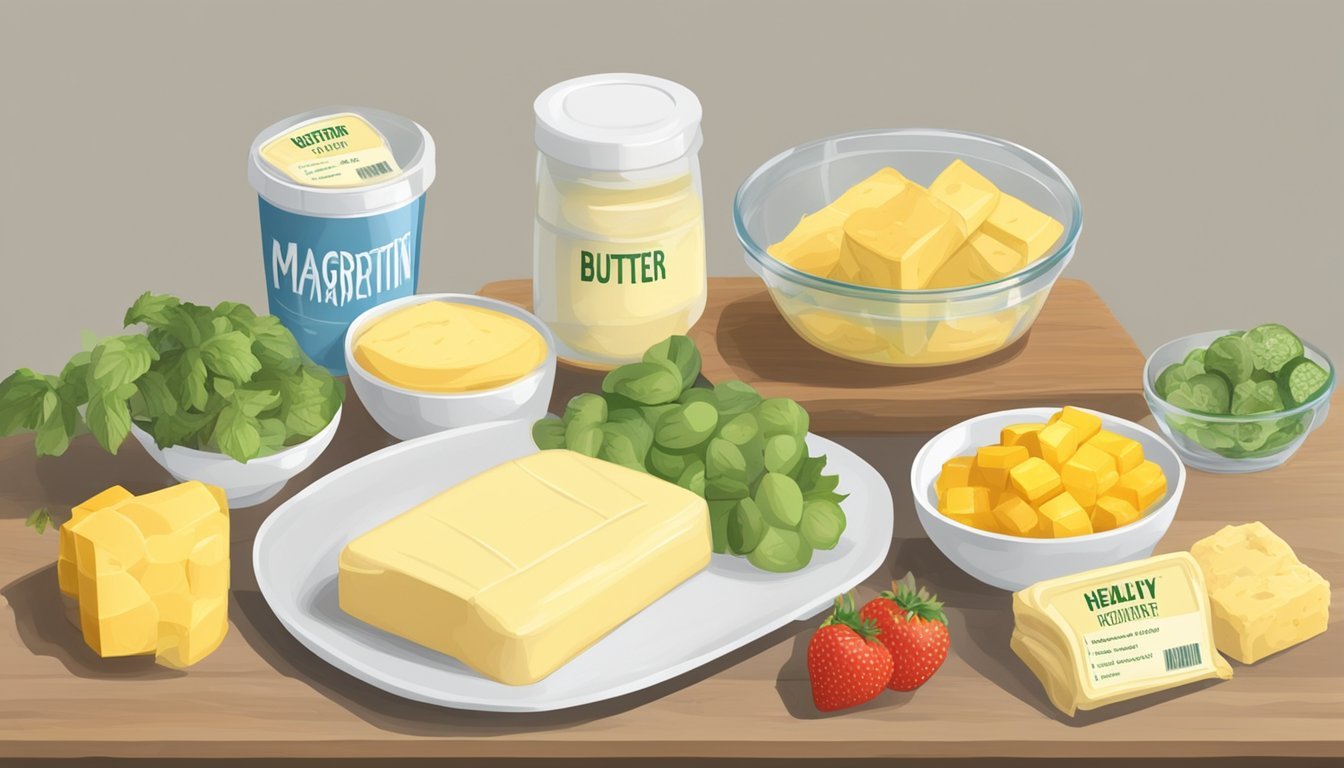Is Margarine Healthier Than Butter?
Unpacking the Facts
The debate between margarine and butter has been a long-standing discussion among health-conscious consumers. Margarine, which is made from vegetable oils, has often been considered the healthier choice due to its unsaturated fats. These fats are said to lower the risk of heart disease when they replace saturated fats found in butter. Butter, a natural product derived from milk or cream, contains saturated fats, which have been linked to higher cholesterol levels.
Despite the traditional views favoring margarine over butter for heart health, recent insights suggest that this may not be so straightforward. Early versions of margarine contained trans fats, a type of fat that has since been recognized as detrimental to cardiovascular health. Newer formulations of margarine have reduced or eliminated these trans fats, but the discussion on health impacts remains nuanced. Modern dietary recommendations are increasingly emphasizing the importance of the overall diet rather than singling out individual food items.
Understanding whether margarine or butter is a healthier choice depends on various factors, including the specific type of margarine, the overall dietary context, and the individual's health goals and conditions. Current knowledge acknowledges that both butter and margarine can be part of a healthy diet when consumed in moderation and as part of a balanced diet rich in whole, nutrient-dense foods.
Composition and Types
This section provides an insight into the ingredients and manufacturing processes for both margarine and butter, with a focus on their respective fat content and variations.
Basic Ingredients and Processing
Margarine is created from a blend of plant-based oils, such as corn, soybean, or palm oils. The oils are often modified through partial hydrogenation, a process that has historically added trans fats to the product. However, newer formulations use less hydrogenated oils to minimize unhealthy trans fats. The base oils are combined with water, salt, emulsifiers, and sometimes milk, with the aim of achieving a texture similar to butter.
Margarine Varieties
There are several types of margarine available on the market:
Stick Margarine: Generally contains more saturated and trans fats due to higher levels of hydrogenation.
Tub Margarine: Lower in saturated fats and designed to be more spreadable; often recommended over stick variants for heart health.
Light Margarine: Contains fewer calories and less saturated fats, due to higher water content.
Each type has varying levels of saturated, unsaturated fats, and trans fats, depending on the specific formulation.
Butter Production
Butter is derived from milk or cream and is churned to separate the fat from the buttermilk. It typically contains at least 80% milk fat, which is mainly saturated fat, along with water and sometimes salt. The simplicity of its ingredients does not necessitate processes like hydrogenation, thereby avoiding the creation of trans fats that are often associated with margarine.
Nutritional Content Comparison
When exploring the health implications of butter and margarine, it is essential to scrutinize their nutritional content, particularly their fat composition, caloric value, cholesterol presence, and the potential inclusion of beneficial nutrients.
Fat Content Analysis
Both butter and margarine are fat-dense foods, yet their types of fat differ significantly. Butter is high in saturated fat because it is derived from animal cream. In contrast, margarine is primarily made from vegetable oils, containing higher amounts of unsaturated fats, including polyunsaturated and monounsaturated fats. Margarines vary in composition; some may include trans fats, which are particularly harmful to cholesterol levels, though many brands have reduced or eliminated these fats due to health concerns.
Calorie and Cholesterol Levels
Calorie-wise, butter and margarine have similar values, with an average of about 100 calories per tablespoon. However, butter contains cholesterol and can contribute to higher LDL cholesterol levels, a risk factor for heart disease. Margarine generally contains no cholesterol but may still impact LDL cholesterol levels depending on the types and amounts of fats used.
Beneficial Additions
Some margarines are fortified with health-promoting additions such as plant sterols and stanols, which can help lower LDL cholesterol. Additionally, they may contain omega-3 fatty acids which are beneficial for heart health. However, these additives are not inherent to margarine and are present due to fortification. It is important to check the labels to ensure these heart-healthy components are included.
Health Impacts
The Health Impacts section examines how margarine and butter consumption may affect cardiovascular health, their association with chronic diseases, and how they align with public health guidelines.
Cardiovascular and Heart Health
Margarine often contains more unsaturated fatty acids than butter, which is predominantly composed of saturated fatty acids. The American Heart Association suggests that unsaturated fats may benefit heart health by improving blood cholesterol levels. Unsaturated fats, typically found in plant products, have been shown to reduce levels of low-density lipoprotein (LDL) cholesterol when they replace saturated fats in the diet. High levels of LDL cholesterol are associated with an increased risk of cardiovascular disease. However, not all margarines are created equal; many soft or liquid margarine varieties are more heart-healthy due to their lower saturated fat content compared to the more solid, stick forms, which may contain trans fats. Trans fats have been recognized by the FDA as a dietary contributor to heart disease and are now largely phased out.
Association With Chronic Diseases
Both butter and margarine intake should be monitored as part of a balanced diet, with particular attention paid to the potential impact on chronic diseases. High saturated fat intake, typically found in butter, has been associated with increased inflammation and a higher risk of chronic conditions, including obesity and some types of cancer. Alternatively, margarine's plant-based oils provide essential vitamins and have been touted in vegan diets for their plant sterols, which can act to lower blood cholesterol. However, it is crucial to choose varieties free of trans fats, which the FDA has identified as unhealthy.
Margarines and Public Health Recommendations
The dietary guidelines and recommendations for margarine consumption have been shaped significantly by public health institutions. The American Heart Association and public health nutrition professionals advocate for the use of margarine over butter as a step toward reducing saturated fat intake in the diet. When selecting a margarine product, the recommendation is to look for those high in unsaturated fats and free of trans fats, aligning with the FDA's removal of partially hydrogenated oils from the "generally recognized as safe" list. Consumers should seek out products labeled as non-hydrogenated to ensure they are choosing a healthier option.
Culinary Uses
Margarine and butter each offer unique characteristics that affect their culinary uses, specifically regarding spreadability, taste, and their roles in cooking and baking. Substitutions among these spreads and various oils can accommodate dietary preferences and health considerations.
Comparing Spreadability and Taste
Margarine is typically more spreadable than butter straight from the refrigerator due to the presence of vegetable oils that remain softer at cooler temperatures. In terms of taste, butter possesses a rich flavor profile often described as creamy and is favored for its natural, traditional dairy taste. On the other hand, margarines vary in flavor depending on the types of plant oils used, such as soybean oil or olive oil, and can be enhanced with additives like salt or emulsifiers.
Cooking and Baking Applications
When it comes to cooking and baking, butter is renowned for contributing a rich flavor and creating a tender crumb in baked goods. It also has a distinct melting behavior that is crucial in pastry making. Margarine, being a blend of various vegetable oils, can serve as an alternative in baking; however, it may alter the texture and flavor of the final product. Not all margarines behave the same way when heated, as those with higher water content may not be suitable for certain baking techniques.
In terms of cooking applications, both butter and margarine can be used for sautéing and pan-frying, although some margarines with lower smoke points might not be as well-suited for high-heat methods.
Alternatives and Substitutions
For those seeking alternatives to butter and traditional margarines, a variety of options exist. Plant-based spreads made from oils like canola, coconut, and extra virgin olive oil can serve similar purposes and may offer different health benefits, such as a lower content of saturated fats. Virgin olive oil and extra virgin olive oil are also commonly used in place of butter for a more Mediterranean style of cooking. These substitutions can be particularly appealing to those with dietary restrictions or preferences for plant oils over animal proteins. It's important to consider the flavor and smoke point of these oils when substituting them in recipes, as they can dramatically change the dish's outcome.
Consumer Considerations
When deciding between butter and margarine, consumers must weigh their options in terms of health, dietary needs, and personal values. Label scrutiny, dietary considerations, and economic and ethical implications play significant roles in this choice.
Label and Ingredient Awareness
Consumers should carefully read labels to understand the nutritional content. Margarine can vary in saturated and trans fats depending on the type. For a heart-healthy diet, one should look for margarine with less than 10% of the daily value for saturated fat. Margarine with phytosterols is designed to help lower cholesterol levels. Vegan olive oil spreads are available for those avoiding animal products but watch out for partially hydrogenated oils, a source of unhealthy trans fats.
Dietary Preferences and Restrictions
Individual dietary needs dictate the choice between butter and margarine. Margarine made from vegetable oils is suitable for a vegan diet, while butter, derived from cows' milk, is not. Those following a paleo diet might avoid margarine due to its processed nature and opt for butter or alternatives like avocado or flaxseed. Considering aspects like carbs, sodium, and calorie intake is crucial for those managing conditions like hypercholesterolemia or aiming for moderation.
Economic and Ethical Factors
Butter typically comes from grain-fed cows, raising concerns about animal welfare and the environment. In contrast, plant-based margarines may appeal to those with ethical considerations about animal agriculture. However, the cost can also be a factor; specialty spreads like those with added phytosterols or organic ingredients may have higher prices. Environmental concerns extend to the production process, with some consumers preferring products made with minimal environmental impact, such as those that do not contain beef tallow or other animal by-products.




